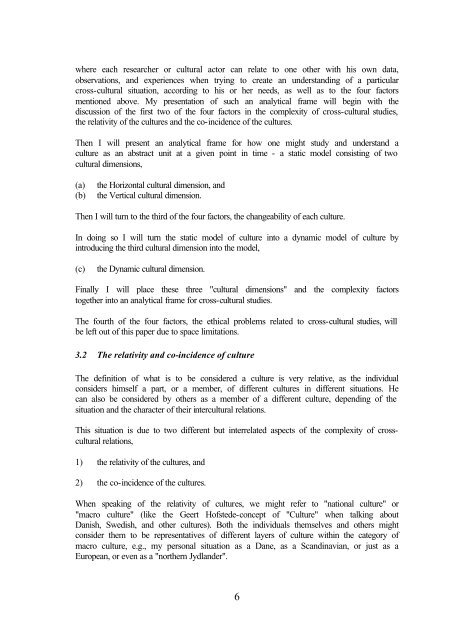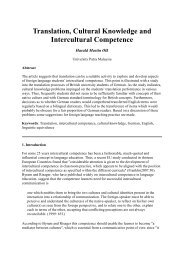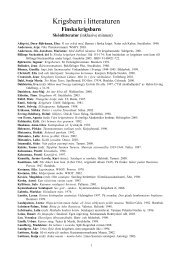the complexity of intercultural communication in cross-cultural
the complexity of intercultural communication in cross-cultural
the complexity of intercultural communication in cross-cultural
You also want an ePaper? Increase the reach of your titles
YUMPU automatically turns print PDFs into web optimized ePapers that Google loves.
where each researcher or <strong>cultural</strong> actor can relate to one o<strong>the</strong>r with his own data,<br />
observations, and experiences when try<strong>in</strong>g to create an understand<strong>in</strong>g <strong>of</strong> a particular<br />
<strong>cross</strong>-<strong>cultural</strong> situation, accord<strong>in</strong>g to his or her needs, as well as to <strong>the</strong> four factors<br />
mentioned above. My presentation <strong>of</strong> such an analytical frame will beg<strong>in</strong> with <strong>the</strong><br />
discussion <strong>of</strong> <strong>the</strong> first two <strong>of</strong> <strong>the</strong> four factors <strong>in</strong> <strong>the</strong> <strong>complexity</strong> <strong>of</strong> <strong>cross</strong>-<strong>cultural</strong> studies,<br />
<strong>the</strong> relativity <strong>of</strong> <strong>the</strong> cultures and <strong>the</strong> co-<strong>in</strong>cidence <strong>of</strong> <strong>the</strong> cultures.<br />
Then I will present an analytical frame for how one might study and understand a<br />
culture as an abstract unit at a given po<strong>in</strong>t <strong>in</strong> time - a static model consist<strong>in</strong>g <strong>of</strong> two<br />
<strong>cultural</strong> dimensions,<br />
(a)<br />
(b)<br />
<strong>the</strong> Horizontal <strong>cultural</strong> dimension, and<br />
<strong>the</strong> Vertical <strong>cultural</strong> dimension.<br />
Then I will turn to <strong>the</strong> third <strong>of</strong> <strong>the</strong> four factors, <strong>the</strong> changeability <strong>of</strong> each culture.<br />
In do<strong>in</strong>g so I will turn <strong>the</strong> static model <strong>of</strong> culture <strong>in</strong>to a dynamic model <strong>of</strong> culture by<br />
<strong>in</strong>troduc<strong>in</strong>g <strong>the</strong> third <strong>cultural</strong> dimension <strong>in</strong>to <strong>the</strong> model,<br />
(c)<br />
<strong>the</strong> Dynamic <strong>cultural</strong> dimension.<br />
F<strong>in</strong>ally I will place <strong>the</strong>se three "<strong>cultural</strong> dimensions" and <strong>the</strong> <strong>complexity</strong> factors<br />
toge<strong>the</strong>r <strong>in</strong>to an analytical frame for <strong>cross</strong>-<strong>cultural</strong> studies.<br />
The fourth <strong>of</strong> <strong>the</strong> four factors, <strong>the</strong> ethical problems related to <strong>cross</strong>-<strong>cultural</strong> studies, will<br />
be left out <strong>of</strong> this paper due to space limitations.<br />
3.2 The relativity and co-<strong>in</strong>cidence <strong>of</strong> culture<br />
The def<strong>in</strong>ition <strong>of</strong> what is to be considered a culture is very relative, as <strong>the</strong> <strong>in</strong>dividual<br />
considers himself a part, or a member, <strong>of</strong> different cultures <strong>in</strong> different situations. He<br />
can also be considered by o<strong>the</strong>rs as a member <strong>of</strong> a different culture, depend<strong>in</strong>g <strong>of</strong> <strong>the</strong><br />
situation and <strong>the</strong> character <strong>of</strong> <strong>the</strong>ir <strong><strong>in</strong>ter<strong>cultural</strong></strong> relations.<br />
This situation is due to two different but <strong>in</strong>terrelated aspects <strong>of</strong> <strong>the</strong> <strong>complexity</strong> <strong>of</strong> <strong>cross</strong><strong>cultural</strong><br />
relations,<br />
1) <strong>the</strong> relativity <strong>of</strong> <strong>the</strong> cultures, and<br />
2) <strong>the</strong> co-<strong>in</strong>cidence <strong>of</strong> <strong>the</strong> cultures.<br />
When speak<strong>in</strong>g <strong>of</strong> <strong>the</strong> relativity <strong>of</strong> cultures, we might refer to "national culture" or<br />
"macro culture" (like <strong>the</strong> Geert H<strong>of</strong>stede-concept <strong>of</strong> "Culture" when talk<strong>in</strong>g about<br />
Danish, Swedish, and o<strong>the</strong>r cultures). Both <strong>the</strong> <strong>in</strong>dividuals <strong>the</strong>mselves and o<strong>the</strong>rs might<br />
consider <strong>the</strong>m to be representatives <strong>of</strong> different layers <strong>of</strong> culture with<strong>in</strong> <strong>the</strong> category <strong>of</strong><br />
macro culture, e.g., my personal situation as a Dane, as a Scand<strong>in</strong>avian, or just as a<br />
European, or even as a "nor<strong>the</strong>rn Jydlander".<br />
6

















